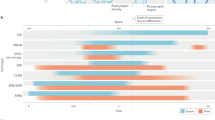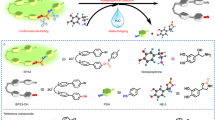Abstract
Brain-derived neurotrophic factor (BDNF) is a promising therapeutic agent for the treatment of neurodegenerative diseases. However, the limited distribution of this molecule after administration into the brain tissue considerably hampers its efficacy. Here, we show how multiphoton microscopy of fluorescently tagged BDNF in brain-tissue slices provides a useful and rapid screening method for examining the diffusion of large molecules in tissues, and for studying the effects of chemical modifications—for example, conjugating with polyethylene glycol (PEG)—on the diffusion constant. This single variable, obtained by monitoring short-term diffusion in real time, can be effectively used for rational drug design. In this study on fluorescently tagged BDNF and BDNF-PEG, we identify slow diffusion as a major contributing factor to the limited penetration of BDNF, and demonstrate how chemical modification can be used to overcome this barrier.
This is a preview of subscription content, access via your institution
Access options
Subscribe to this journal
Receive 12 print issues and online access
$259.00 per year
only $21.58 per issue
Buy this article
- Purchase on Springer Link
- Instant access to full article PDF
Prices may be subject to local taxes which are calculated during checkout





Similar content being viewed by others
References
Thoenen, H. & Sendtner, M. Neurotrophins: from enthusiastic expectations through sobering experiences to rational therapeutic approaches. Nature Neurosci. 5 (suppl), 1046–1050 (2002).
Mahoney, M.J. & Saltzman, W.M. Millimeter-scale positioning of a nerve-growth-factor source and biological activity in the brain. Proc. Natl Acad. Sci. USA 96, 4536–4539 (1999).
Burke, M.A. et al. Loss of developing cholinergic basal forebrain neurons following excitotoxic lesions of the hippocampus: rescue by neurotrophins. Exp. Neurol. 130, 178–195 (1994).
Morse, J.K. et al. Brain-derived neurotrophic factor (BDNF) prevents the degeneration of medial septal cholinergic neurons following fimbria transection. J. Neurosci. 13, 4146–4156 (1993).
Levi-Montalcini, R. The nerve growth factor 35 years later. Science 237, 1154–1162 (1987).
Belcheva, N., Woodrow-Mumford, K., Mahoney, M. & Saltzman, W.M. Synthesis and biological activity of polyethylene glycol-mouse nerve growth factor conjugate. Bioconjugate Chem. 10, 932–937 (1999).
Croll, S.D. et al. Co-infusion with a TrkB-Fc receptor body carrier enhances BDNF distribution in the adult rat brain. Exp. Neurol. 152, 20–33 (1998).
Kasaian, M., Jacobberger, J.W. & Neet, K.E. Flow cytometric analysis of fluorescein-labeled nerve growth factor binding to A875 human melanoma cells. Exp. Cell Res. 210, 77–85 (1994).
Rosenfeld, R. et al. Purification and identification of brain-derived neurotrophic factor from human serum. Protein Express. Purif. 6, 465–471 (1995).
Krewson, C., Klarman, M. & Saltzman, W.M. Distribution of nerve growth factor following direct delivery to brain interstitium. Brain Res. 680, 196–206 (1995).
Krewson, C.E. & Saltzman, W.M. Transport and elimination of recombinant human NGF during long-term delivery to the brain. Brain Res. 727, 169–181 (1996).
Anderson, K. et al. Differential distribution of exogenous BDNF, NGF, and NT-3 in the brain corresponds to the relative abundance and distribution of high-affinity and low affinity neurotrophin receptors. J. Comp. Neurol. 357, 296–317 (1995).
Yan, Q. et al. Distribution of intracerebral ventricularly administered neurotrophins in rat brain and its correlation with trk receptor expression. Exp. Neurol. 127, 23–26 (1994).
Ankeny, D. et al. Pegylated brain-derived neurotrophic factor shows improved distribution into the spinal cord and stimulates locomotor activity and morphological changes after injury. Exp. Neurol. 170, 85–100 (2001).
Williams, R.M., Zipfel, W.R. & Webb, W.W. Multiphoton microscopy in biological research. Curr. Opin. Chem. Biol. 5, 603–608 (2001).
Denk, W., Strickler, J.H. & Webb, W.W. Two-photon laser scanning fluorescence microscopy. Science 248, 73–76 (1990).
Stroh, M., Zipfel, W.R., Williams, R.M., Webb, W.W. & Saltzman, W.M. Diffusion of nerve growth factor in rat striatum as determined by multiphoton microscopy. Biophys. J. 85, 581–588 (2003).
Radomsky, M.L., Whaley, K.J., Cone, R.A. & Saltzman, W.M. Macromolecules released from polymers: diffusion into unstirred fluids. Biomaterials 11, 619–624 (1990).
Rice, M.E. & Nicholson, C. Diffusion characteristics and extracellular volume fraction during normoxia and hypoxia in slices of rat neostriatum. J. Neurophysiol. 65, 264–272 (1991).
Sykova, E. The extracellular space in the CNS: its regulation, volume and geometry in normal and pathological neuronal function. Neuroscientist 3, 28–41 (1997).
Pluen, A., Netti, P.A., Jain, R.K. & Berk, D.A. Diffusion of macromolecules in agarose gels: Comparison of linear and globular configurations. Biophys. J. 77, 542–552 (1999).
Prokopova-Kubinova, S. et al. Poly[N-(2-hydroxypropyl)methacrylamide] polymers diffuse in brain extracellular space with same tortuosity as small molecules. Biophys. J. 80, 542–548 (2001).
Berk, D.A., Yuan, F., Leunig, M. & Jain, R.K. Direct in vivo measurement of targeted binding in a human tumor xenograft. Proc. Natl Acad. Sci. USA 94, 1785–1790 (1997).
Nugent, L.J. & Jain, R.K. Extravascular diffusion in normal and neoplastic tissues. Cancer Res. 44, 238–244 (1984).
Leibrock, J. et al. Molecular cloning and expression of brain-derived neurotrophic factor. Nature 341, 149–152 (1989).
Bullock, J. et al. Comparison of results of various methods used to determine the extent of modification of methoxy polyethylene glycol 5000-modified bovine cupri-zinc superoxide dismutase. Anal. Biochem. 254, 254–262 (1997).
Nicholson, C. & Tao, L. Hindered diffusion of high molecular weight compounds in brain extracellular microenvironment measured with integrative optical imaging. Biophys. J. 65, 2277–2290 (1993).
Berg, H.C. Random Walks in Biology (Princeton Univ. Press, Princeton, 1983).
Fung, L., Shin, M., Tyler, B., Brem, H. & Saltzman, W.M. Chemotherapeutic drugs released from polymers: distribution on 1,3-bis(2-chloroethyl)-1-nitrosourea in the rat brain. Pharm. Res. 13, 671–682 (1996).
Lane, R.H., Tsirka, A.E. & Gruetzmacher, E.M. Uteroplacental insufficiency alters cerebral mitochondrial gene expression and DNA in fetal and juvenile rats. Pediatr. Res. 47, 792–797 (2000).
Brown, E.B., Wu, E.S., Zipfel, W. & Webb, W.W. Measurement of molecular diffusion in solution by multiphoton fluorescence photobleaching recovery. Biophys. J. 77, 2837–2849 (1999).
Zipfel, W.R. & Webb, W.W. in Methods in Cellular Imaging (ed. Periasamy, A.) 216–235 (Oxford Univ. Press, Oxford, 2001).
Zhang, F., Kang, E.T., Neoh, K.G., Wang, P. & Tan, K.L. Modification of Si(100) surface by the grafting of poly(ethylene glycol) for reduction in protein adsorption and platelet adhesion. J. Biomed. Mater. Res. 56, 324–332 (2001).
Bearinger, J.P. et al. Chemisorbed poly(propylene sulphide)-based copolymers resist biomolecular interactions. Nature Mater. 2, 259–264 (2003).
Gref, R. et al. 'Stealth' corona-core nanoparticles surface modified by polyethylene glycol (PEG): influences of the corona (PEG chain length and surface density) and of the core composition on phagocytic uptake and plasma protein adsorption. Colloids Surf. B 18, 301–313 (2000).
Tao, L. & Nicholson, C. The three-dimensional point spread functions of a microscope objective in image and object space. J. Microsc. 178, 267–271 (1995).
Kinstler, O.B. & Yan, Q. BDNF and NT-3 polypeptides selectively linked to polyethylene glycol. US Patent 5,770,5777 (1998).
Sakane, T. & Pardridge, W.M. Carboxyl-directed pegylation of brain-derived neurotrophic factor markedly reduces systemic clearance with minimal loss of biologic activity. Pharm. Res. 14, 1085–1091 (1997).
Hermanson, G.T. Bioconjugate Techniques (Academic, San Diego, 1996).
Kloppenburg, P., Zipfel, W.R., Webb, W.W. & Harris-Warrick, R.M. Highly localized Ca(2+) accumulation revealed by multiphoton microscopy in an identified motoneuron and its modulation by dopamine. J. Neurosci. 20, 2523–2533 (2000).
Acknowledgements
We thank Moses V. Chao for his generous gift of the trkB-expressing PC12 cell line, and Amgen for the kind donation of all BDNF used in this study. This work was supported by grants from the National Institutes of Health (NS-38470 and NS-45236, S.C.M., M.S. and W.M.S.). This publication was made possible in part by Grant Number P41-RR04224 from the National Center for Research Resources, National Institutes of Health to R.M.W, W.R.Z. and W.W.W.
Author information
Authors and Affiliations
Corresponding author
Ethics declarations
Competing interests
The authors declare no competing financial interests.
Rights and permissions
About this article
Cite this article
Stroh, M., Zipfel, W., Williams, R. et al. Multiphoton microscopy guides neurotrophin modification with poly(ethylene glycol) to enhance interstitial diffusion. Nature Mater 3, 489–494 (2004). https://doi.org/10.1038/nmat1159
Received:
Accepted:
Published:
Issue Date:
DOI: https://doi.org/10.1038/nmat1159
This article is cited by
-
Nanovaccine-based strategies for lymph node targeted delivery and imaging in tumor immunotherapy
Journal of Nanobiotechnology (2023)
-
Material design for lymph node drug delivery
Nature Reviews Materials (2019)
-
Designing Bioactive Delivery Systems for Tissue Regeneration
Annals of Biomedical Engineering (2011)
-
Diffusion measurements for drug design
Nature Materials (2005)
-
Diffusion measurements for drug design
Nature Materials (2005)



